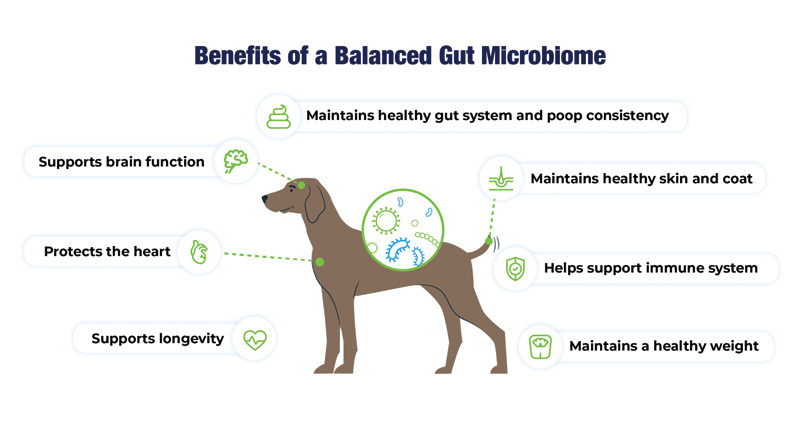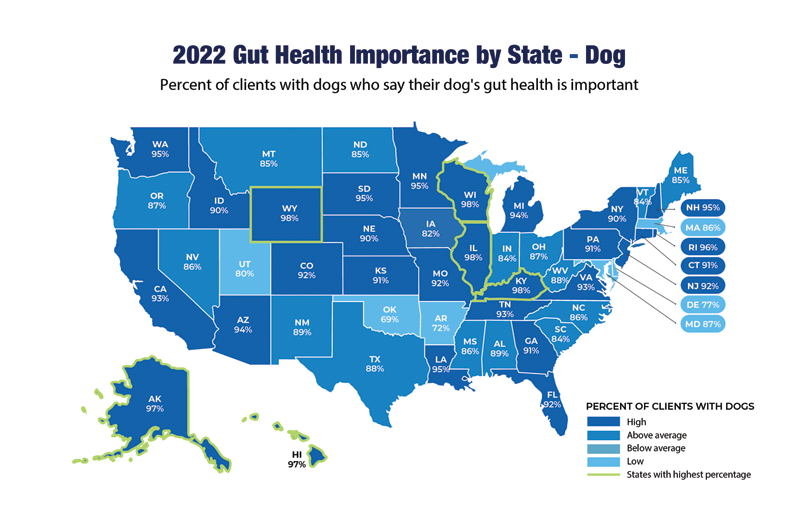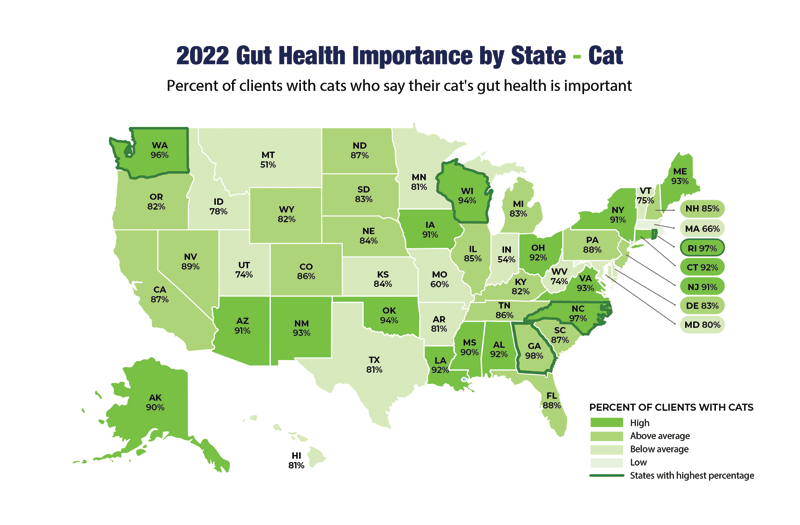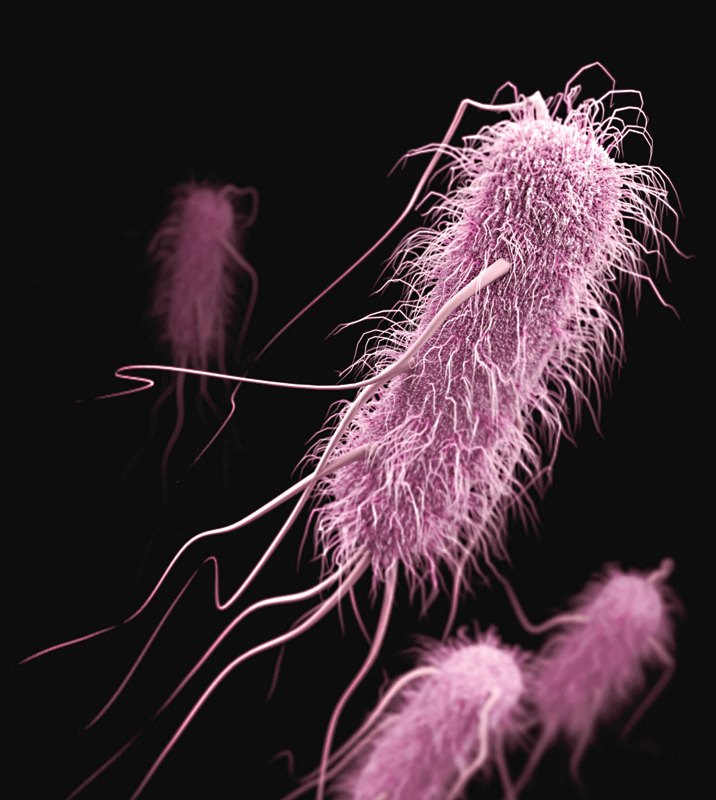
Skin and digestive conditions account for more than half of all veterinary visits annually, affecting more than 60 million cats and dogs.1 These conditions are associated with imbalances in the gut microbiome (e.g. skin2 and chronic enteropathies3).
The gut microbiome is a complex microbial community (archaea, bacteria, fungi, protozoa, and viruses) found in the gastrointestinal tract that is foundational to health, supporting—among other things—digestion,4 immunity,5 and the central nervous system.6 (Figure 1)
Awareness of the importance of the gut microbiome to overall health is rising in both veterinary and human medicine. To assess how aware pet owners are about the significance of gut health, a nationwide survey was conducted, asking 2,000 cat owners and 2,000 dog owners in the United States7 what they think about gut health in general, their knowledge of how to support and improve their pet’s gut health, and the role their veterinarian plays in guiding them. The findings present opportunities for veterinarians to not only improve outcomes for their patients, but also provide the necessary education clients need to better understand the gut microbiome and its influences on pet health.
Client awareness on gut health
Most owners are aware gut health matters for their pet’s overall health. Over 90 percent of dog owners said it is important for dogs, and these findings were consistent across the United States.7 For cats, 87 percent of owners said their pet’s gut health was important, but the results varied more from state to state.7 These findings may, to some extent, reflect differences between cat and dog ownership in lifestyles and care (Figures 2 and 3).

Diet. Feeding a well-balanced diet that supports a diversity of microbes and function in the gut is essential for maintaining health.8 However, 33 percent of pet owners were unaware that diet played an essential role in gut health.7 Given the importance of a healthful diet in supporting both proper nutrition and gut function, this finding shows just how important it is to discuss nutrition with your clients. An appropriately balanced diet is an important way to maintain the gut microbiome by supporting beneficial bacteria and discouraging harmful bacteria from populating the gut.
Disease and medications. Pet owners are aware disease and medications will affect their pet’s gut health. Infectious disease and chronic diseases contribute to imbalances in the gut microbiome with important implications for overall health and the subsequent development of both acute and chronic conditions. For example, infections by the enteropathogen, Giardia spp. alter community composition and function of commensal bacteria, including the structure of intestinal biofilms.9 Treating infections such as Giardia with antibiotics and antiparasitics can further compound gut dysbiosis. Addressing this dysbiosis subsequent to treatment may be helpful in aiding recovery.
A growing number of studies are identifying non-target effects of medications on commensal bacteria in the gut microbiome, particularly medications that have large effects like antibiotics10 and proton pump inhibitors.11,12
Symptoms of gut dysbiosis. Many cats and dogs experience symptoms associated with gut dysbiosis, most commonly skin and digestive conditions. In the past 12 months, 31 percent of cats and 42 percent of dogs were reported to have experienced skin issues, and 43 percent of cats and 56 percent of dogs experienced diarrhea.7
A majority of cat owners (53 percent) and dog owners (67 percent) reported that their pet experienced four or more symptoms that have been associated with imbalances in the gut microbiome: diarrhea, soft stool, weight change, skin issues, bad breath, vomiting, lack of energy, appetite change, constipation, behavioral issues, and pica.7
Client-vet relationship
An overwhelming majority of pet owners who visit their veterinarian reported feeling confident in the treatment plan (89 percent of dog parents and 87 percent of cat parents), and 90 percent of dog parents and 89 percent of cat parents said they would recommend their veterinarian to others.7

Unfortunately, compliance is poor and just 35 percent of pet parents in the survey reported that they closely followed their veterinarian’s treatment plan. Unsurprisingly, 19 percent of dog parents and 28 percent of cat parents said that symptoms remained unresolved after a visit to the vet, and 64 percent of dog parents and 65 percent of cat parents say their current treatments were not completely effective.7
When followed by pet owners, treatment plans may still fail if they do not address or further compound the underlying dysbiosis that has led to clinical symptoms. Both metronidazole and tylosin have very high relapse rates in dogs with chronic enteropathies (tylosin: 88 percent within two months,13,14 metronidazole: 100 percent within six to 12 months, T. Spillmann), which results in repeated administration.
Studies of long-term effects from short courses of commonly used medications on the fecal microbiome lend support for more careful consideration of when to administer antibiotics as well as proton pump inhibitors (PPIs) and a reduction in prophylactic use. Short courses of metronidazole in dogs resulted in significantly altered fecal bacterial composition15 and dysbiosis that persisted for more than four weeks after its discontinuation.16
Similarly, administration of tylosin to healthy dogs significantly altered the jejunal microbiome17 and caused fecal dysbiosis and reduced bile acid conversion, with effects lasting for at least eight weeks.18
Coadministration of the NSAID carprofen with the PPI omeprazole for seven days resulted in fecal dysbiosis and increased intestinal inflammation in six healthy beagle dogs.12
These findings present veterinarians and pet parents with an opportunity to use gut microbiome testing for dysbiosis to identify factors that may be contributing to gastrointestinal disease.
Testing for dysbiosis in fecal samples
Testing for gut dysbiosis can be performed on fecal samples via PCR for a select group of bacterial targets19,20 or by DNA sequencing which looks at many more targets.21 Both approaches require an understanding of the composition of gut bacteria in the microbiome of healthy individuals.

A study presented at the American College of Veterinary Internal Medicine (ACVIM) Forum found strong support for the presence of a taxonomically defined core fecal microbiome in healthy pet cats and dogs in data from a sizable fecal biobank (more than 4,000 samples).21
Using the ranges defined by the healthy reference set, the researchers found that elevated levels of Escherichia-Shigella (E. coli) are common in fecal samples from dogs and cats: 28 percent (nearly one in three) dogs and in 13 percent (one in seven) cats had elevated levels of E. coli. 21 Elevated levels of E. coli were significantly associated with clinical signs, gastrointestinal disease diagnoses, and recent antibiotic exposure. In addition, this was associated with multiple depletions of individual core fecal microbiome taxa necessary to maintain a healthy gut.
While E. coli is a normal inhabitant of the gastrointestinal tract, it can also act as a pathobiont. Like Clostridioides difficile, E. coli is an opportunistic pathogen that emerges after antibiotic exposure has depleted the diversity of bacteria in the gut microbiome. In addition to increasing the risk of inflammation and digestive issues, E. coli also kills beneficial bacteria and scavenges iron, reducing the body’s defenses to infection.
These findings are not surprising given that metronidazole is commonly used to treat diarrhea associated with overgrowths of Clostridium perfringens but does not address elevated levels of E. coli. To further compound this effect, a growing body of research shows that even short-term antibiotic use can have lasting non-target effects on other groups of commensal gut bacteria, thus continuing the cycle of dysbiosis within the gut (Figure 4).
Taking care of your patient’s gut health
While clients may request antibiotics, these studies urge consideration of alternatives that may be helpful in resolving symptoms like diarrhea without causing damage to inhabitants of the gut microbiome. These alternatives may include hydrolyzed22 and fiber rich diets, the addition of prebiotic fibers23, yeast probiotics24, bacterial probiotics with bacteriophages that target E. coli25, and fecal microbiota transplantation.26
Tonya Cooksey, DVM, is director of veterinary relations at AnimalBiome. Dr. Cooksey received her doctorate in veterinary medicine from Auburn University in 2006, with an interest in small animal medicine and soft tissue surgery. She continues her passion for patient advocacy in her new role, improving veterinary understanding of the gut microbiome and its influence on the health of pets.
Holly Ganz, PhD, is chief science officer and cofounder of AnimalBiome. Dr. Ganz received her PhD from the University of California, Davis and was a postdoctoral scholar at UC Berkeley. Her efforts to translate academic research into solutions for companion animals began in 2015 when she launched KittyBiome, a citizen science project, which revealed that imbalances in the gut microbiome are common in pets and there was a pressing need for better approaches to maintain and restore gut health.
References
- Cost of Pet Health Care Report 2019. “Cost of Pet Health Care Report” by Healthy Paws Insurance. https://www.healthypawspetinsurance.com/cost-of-pet-care
- Rostaher, A., Morsy, Y., Favrot, C., Unterer, S., Schnyder, M., Scharl, M., and Fischer, N.M. (2022). Comparison of the Gut Microbiome between Atopic and Healthy Dogs—Preliminary Data. Animals 12, 2377. https://pubmed.ncbi.nlm.nih.gov/36139237
- Honneffer, J.B., Minamoto, Y., and Suchodolski, J.S. (2014). Microbiota alterations in acute and chronic gastrointestinal inflammation of cats and dogs. World J. Gastroenterol. 20, 16489–16497. https://pubmed.ncbi.nlm.nih.gov/25469017
- Pilla, R., and Suchodolski, J.S. (2021). The Gut Microbiome of Dogs and Cats, and the Influence of Diet. Vet. Clin. North Am. Small Anim. Pract. 51, 605–621. https://pubmed.ncbi.nlm.nih.gov/33653538
- Shi, N., Li, N., Duan, X., and Niu, H. (2017). Interaction between the gut microbiome and mucosal immune system. Mil Med Res 4, 14. https://www.ncbi.nlm.nih.gov/pmc/articles/PMC5408367
- Wang, Y., Wang, Z., Wang, Y., Li, F., Jia, J., Song, X., Qin, S., Wang, R., Jin, F., Kitazato, K., et al. (2018). The Gut-Microglia Connection: Implications for Central Nervous System Diseases. Frontiers in Immunology 9. 10.3389/fimmu.2018.02325. https://www.frontiersin.org/articles/10.3389/fimmu.2018.02325
- State of the gut State of the Gut. https://stateofthegut.com
- Wernimont, S.M., Radosevich, J., Jackson, M.I., Ephraim, E., Badri, D.V., MacLeay, J.M., Jewell, D.E., and Suchodolski, J.S. (2020). The Effects of Nutrition on the Gastrointestinal Microbiome of Cats and Dogs: Impact on Health and Disease. Front. Microbiol. 11, 1266. https://www.ncbi.nlm.nih.gov/pmc/articles/PMC7329990/
- Fekete, E., Allain, T., Siddiq, A., Sosnowski, O., and Buret, A.G. (2020). Giardia spp. and the Gut Microbiota: Dangerous Liaisons. Front. Microbiol. 11, 618106. https://pubmed.ncbi.nlm.nih.gov/33510729
- Dethlefsen, L., and Relman, D.A. (2011). Incomplete recovery and individualized responses of the human distal gut microbiota to repeated antibiotic perturbation. Proc. Natl. Acad. Sci. U. S. A. 108 Suppl 1, 4554–4561. https://www.pnas.org/doi/10.1073/pnas.1000087107
- Imhann, F., Vich Vila, A., Bonder, M.J., Lopez Manosalva, A.G., Koonen, D.P.Y., Fu, J., Wijmenga, C., Zhernakova, A., and Weersma, R.K. (2017). The influence of proton pump inhibitors and other commonly used medication on the gut microbiota. Gut Microbes 8, 351–358. https://www.ncbi.nlm.nih.gov/pmc/articles/PMC5570416
- Jones, S.M., Gaier, A., Enomoto, H., Ishii, P., Pilla, R., Price, J., Suchodolski, J., Steiner, J.M., Papich, M.G., Messenger, K., et al. (2020). The effect of combined carprofen and omeprazole administration on gastrointestinal permeability and inflammation in dogs. J. Vet. Intern. Med. 34, 1886–1893. https://www.ncbi.nlm.nih.gov/pmc/articles/PMC7517840
- Westermarck, E., Skrzypczak, T., Harmoinen, J., Steiner, J.M., Ruaux, C.G., Williams, D.A., Eerola, E., Sundbäck, P., and Rinkinen, M. (2005). Tylosin-responsive chronic diarrhea in dogs. J. Vet. Intern. Med. 19, 177–186. https://pubmed.ncbi.nlm.nih.gov/15822561
- Kilpinen, S., Spillmann, T., and Westermarck, E. (2014). Efficacy of two low-dose oral tylosin regimens in controlling the relapse of diarrhea in dogs with tylosin-responsive diarrhea: a prospective, single-blinded, two-arm parallel, clinical field trial. Acta Vet. Scand. 56, 43. https://pubmed.ncbi.nlm.nih.gov/25096196/
- Igarashi, H., Maeda, S., Ohno, K., Horigome, A., Odamaki, T., and Tsujimoto, H. (2014). Effect of oral administration of metronidazole or prednisolone on fecal microbiota in dogs. PLoS One 9, e107909. https://journals.plos.org/plosone/article?id=10.1371/journal.pone.0107909
- Pilla, R., Gaschen, F.P., Barr, J.W., Olson, E., Honneffer, J., Guard, B.C., Blake, A.B., Villanueva, D., Khattab, M.R., AlShawaqfeh, M.K., et al. (2020). Effects of metronidazole on the fecal microbiome and metabolome in healthy dogs. J. Vet. Intern. Med. 34, 1853–1866. https://pubmed.ncbi.nlm.nih.gov/32856349/
- Suchodolski, J.S., Dowd, S.E., Westermarck, E., Steiner, J.M., Wolcott, R.D., Spillmann, T., and Harmoinen, J.A. (2009). The effect of the macrolide antibiotic tylosin on microbial diversity in the canine small intestine as demonstrated by massive parallel 16S rRNA gene sequencing. BMC Microbiol. 9, 210. https://pubmed.ncbi.nlm.nih.gov/19799792/
- Manchester, A.C., Webb, C.B., Blake, A.B., Sarwar, F., Lidbury, J.A., Steiner, J.M., and Suchodolski, J.S. (2019). Long-term impact of tylosin on fecal microbiota and fecal bile acids of healthy dogs. J. Vet. Intern. Med. 33, 2605–2617. https://pubmed.ncbi.nlm.nih.gov/31674054/
- Vázquez-Baeza, Y., Hyde, E.R., Suchodolski, J.S., and Knight, R. (2016). Dog and human inflammatory bowel disease rely on overlapping yet distinct dysbiosis networks. Nat Microbiol 1, 16177. https://pubmed.ncbi.nlm.nih.gov/27694806/
- Sung, C.-H., Marsilio, S., Chow, B., Zornow, K.A., Slovak, J.E., Pilla, R., Lidbury, J.A., Steiner, J.M., Park, S.Y., Hong, M.-P., et al. (2022). Dysbiosis index to evaluate the fecal microbiota in healthy cats and cats with chronic enteropathies. J. Feline Med. Surg. 24, e1–e12. https://pubmed.ncbi.nlm.nih.gov/35266809/
- Jessica K. Jarett, Dawn D. Kingsbury, Carlton X. Osborne, Alex L. Martin, Jonathan A. Eisen, and Holly H. Ganz. Defining Healthy: The Utility of Building a Companion Animal Fecal Microbiome Reference Dataset. ACVIM 2020 Forum On Demand. https://www.ncbi.nlm.nih.gov/pmc/articles/PMC7968404/
- Wang, S., Martins, R., Sullivan, M.C., Friedman, E.S., Misic, A.M., El-Fahmawi, A., De Martinis, E.C.P., O’Brien, K., Chen, Y., Bradley, C., et al. (2019). Diet-induced remission in chronic enteropathy is associated with altered microbial community structure and synthesis of secondary bile acids. Microbiome 7, 126. https://microbiomejournal.biomedcentral.com/articles/10.1186/s40168-019-0740-4
- Fritsch, D.A., Wernimont, S.M., Jackson, M.I., MacLeay, J.M., and Gross, K.L. (2022). A prospective multicenter study of the efficacy of a fiber-supplemented dietary intervention in dogs with chronic large bowel diarrhea. BMC Vet. Res. 18, 244. https://bmcvetres.biomedcentral.com/articles/10.1186/s12917-022-03302-8
- Aktas M, Borku M, Ozkanlar Y. Efficacy of Saccharomyces boulardii as a probiotic in dogs with lincomycin induced diarrhoea. Bull Vet Inst Pulawy. 2007;51:365-369. http://www.allnaturalpetcare.com/Holistic_Pet_Remedies/Probiotics-Dogs_Diarrhoea_Antibiotics.pdf
- Grubb, D.S., Wrigley, S.D., Freedman, K.E., Wei, Y., Vazquez, A.R., Trotter, R.E., Wallace, T.C., Johnson, S.A., and Weir, T.L. (2020). PHAGE-2 Study: Supplemental Bacteriophages Extend Bifidobacterium animalis subsp. lactis BL04 Benefits on Gut Health and Microbiota in Healthy Adults. Nutrients 12. 10.3390/nu12082474. https://www.ncbi.nlm.nih.gov/pmc/articles/PMC7468981/
- Gal, A., Barko, P.C., Biggs, P.J., Gedye, K.R., Midwinter, A.C., Williams, D.A., Burchell, R.K., and Pazzi, P. (2021). One dog’s waste is another dog’s wealth: A pilot study of fecal microbiota transplantation in dogs with acute hemorrhagic diarrhea syndrome. PLoS One 16, e0250344. https://pubmed.ncbi.nlm.nih.gov/33872339/
